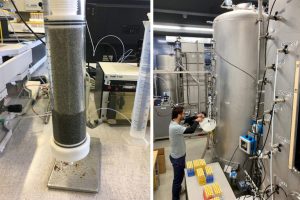
Microplastics are ubiquitous in the environment and have been detected in marine water, wastewater, and even in drinking water, both bottled and tap water. This has led to concerns about the efficacy of current drinking water treatment processes to remove these contaminants.
In 2019, Eawag and the Zurich Water Works launched a joint project to find out whether the tiniest of particles, measuring less than a thousandth of a millimeter across, actually find their way from lake water into drinking water pipes and therefore into homes, hospitals and restaurants. The team has now published the results in the Journal of Hazardous Materials.
The new study investigated the performance of different techniques when it comes to removing nanoplastics from drinking water. Researchers found that the biologically active slow sand filter was the most effective at retaining nanoparticles – achieving an efficacy level in the region of 99.9%. This was shown both in the laboratory tests and in larger, realistic tests and modeling.
https://www.inceptivemind.com/slow-sand-filter-remove-nanoplastics-drinking-water/24937/
